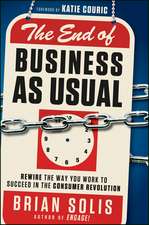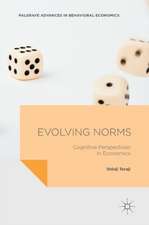Economics of Pessimism and Optimism: Theory of Knightian Uncertainty and Its Applications
Autor Kiyohiko G. Nishimura, Hiroyuki Ozakien Limba Engleză Hardback – 21 noi 2017
Kiyohiko Nishimura is Professor at the National Graduate Institute for Policy Studies (GRIPS) and Professor Emeritus and Distinguished Project Research Fellow of the Center for Advanced Research in Finance at The University of Tokyo. Hiroyuki Ozaki is Professor of Economics at Keio University.
| Toate formatele și edițiile | Preț | Express |
|---|---|---|
| Paperback (1) | 787.30 lei 38-44 zile | |
| Springer – 3 sep 2018 | 787.30 lei 38-44 zile | |
| Hardback (1) | 953.03 lei 6-8 săpt. | |
| Springer – 21 noi 2017 | 953.03 lei 6-8 săpt. |
Preț: 953.03 lei
Preț vechi: 1162.23 lei
-18% Nou
Puncte Express: 1430
Preț estimativ în valută:
182.39€ • 188.16$ • 154.36£
182.39€ • 188.16$ • 154.36£
Carte tipărită la comandă
Livrare economică 04-18 martie
Preluare comenzi: 021 569.72.76
Specificații
ISBN-13: 9784431559016
ISBN-10: 4431559019
Pagini: 330
Ilustrații: XX, 326 p. 12 illus. in color.
Dimensiuni: 155 x 235 x 25 mm
Greutate: 0.66 kg
Ediția:1st ed. 2017
Editura: Springer
Colecția Springer
Locul publicării:Tokyo, Japan
ISBN-10: 4431559019
Pagini: 330
Ilustrații: XX, 326 p. 12 illus. in color.
Dimensiuni: 155 x 235 x 25 mm
Greutate: 0.66 kg
Ediția:1st ed. 2017
Editura: Springer
Colecția Springer
Locul publicării:Tokyo, Japan
Cuprins
1 Overall Introduction.- 2 Mathematics for Reading Later Chapters.- 3 Decision-Theoretic Foundations of Knightian Uncertainty.- 4 Portfolio Inertia.- 5 Equilibrium Indeterminacy in Arrow-Debreu Economy with Knightian Uncertainty.- 6 Monetary Equilibria and Knightian Uncertainty.- 7 Dynamic Programming.- 8 Dynamic Asset Pricing.- 9 Search and Knightian Uncertainty.- 10 Irreversible Investment and Knightian Uncertainty.- 11 Liquidity Preference and Knightian Uncertainty.- 12 A Simple Characterization of Pessimism and Optimism: e-Contamination Versus e-Exuberance.- 13 Persistent Pessimism and Optimism in Forecasts: Implicit Means and Law of Iterated Integrals.- 14 Learning Under Knightian Uncertainty.- 15 Areas of Further Research.- Appendix Proofs of Lemmas and Theorems.- Index.
Recenzii
This book was awarded the 61st Nikkei Prize for Excellent Books in Economic Science 2018 by The Japan Center for Economic Research
“To summarize, this book, jointly written by the two prominent economists Nishimura and Ozaki, is no doubt a monumental achievement on the economics of ambiguity and uncertainty. It is well organized and mathematically sophisticated. It is expected to be read by two types of readers: highly mathematically trained researchers and general theoretical scholars with less technical orientation. I believe that application-oriented researchers and policy-makers may also benefit from careful reading of such a first-rate work.” (Yasuhiro Sakai, Journal of Economic Psychology, Vol. 72, June, 2019)
“The recent monograph by Nishimura and Ozaki, entitled Economics of Pessimism and Optimism: Theory of Knightian Uncertainty and Its Applications, provides a summary of this exciting new research. … Despite being limited to the CEU/MEU formulation of Knightian Uncertainty, the recent monograph by Nishimura and Ozaki is an ideal resource for those looking to catch up to the current research frontier on Knightian Uncertainty. It is well written and well organized.” (Ken Kasa, International Finance, February, 15, 2019)
“Kiyohiko Nishimura and Hiroyuki Ozaki have produced a thorough, scholarly, and mathematical rigorous treatment of decision theory when the probability distribution governing uncertainty is unknown … . Nishimura and Ozaki are to be congratulated on their thorough and innovative treatment of how to use convex Choquet capacities to make fundamental uncertainty operational, under certain assumptions. Their book will be indispensable to, and warmly welcomed by, technically oriented researchers in decision theory.” (Robert W. Dimand, Journal of Economics, Vol. 124, 2018)
Notă biografică
Kiyohiko G. NishimuraKiyohiko G. Nishimura is emeritus professor of economics and distinguished project research fellow at The University of Tokyo and a professor of economics in the National Graduate Institute for Public Policy (GRIPS). Before returning to academia, he was deputy governor of the Bank of Japan for 5 years until March 19, 2013, one of the most turbulent periods in the history of the world economy and central banking. He received his B.A. (1975) and M.A. (1977) from The University of Tokyo and his Ph.D. (1982) from Yale University. He was associate professor (1983–1994) and professor (1994–2005). He joined the Bank of Japan as a Member of its Policy Board (2005–2008), and then as deputy governor (2008–2013). He was dean of the Graduate School of Economics at The University of Tokyo (2013–2015). Since February 2014, he has been chairman of the Statistics Commission of the Government of Japan. He received the Nikkei Prize in 1993, the Japan Economist Prize in 1997, and the TELECOM Social Science Award in 2006. He was also the winner of the Japanese Economic Association Nakahara Prize in 1998 for his outstanding international contribution to mathematical economics and economic theory. He was awarded Emperor ’s Medal of Honor with Purple Ribbon in 2015 for his outstanding contribution to theoretical economics.
Hiroyuki Ozaki
Hiroyuki Ozaki is professor of economics at Keio University. He has been particularly active in developing the theory of dynamic decision making, where non-additive probability measures are used, with applications to elucidation of macroeconomic phenomena that are hard to explain in the traditional additive probability framework. He received his B.A. (1986) from Keio University and his Ph.D. (1992) from The University of Wisconsin at Madison, where he majored in economics and minored in mathematics. He was assistant professor at The University of Western Ontario (1993–1996) and associate professor at Tohoku University (1996–2005) before joining the Faculty of Economics at Keio University in 2005. He has been professor at Keio University since then. Dr. Ozaki’s academic research focuses on mathematical economics and the decision-theoretic foundation of economic agents’ behavior. Among his numerous contributions to this field, most notable is: "Dynamic programming for non-additive stochastic objectives," Journal of Mathematical Economics 25 (1996), 391–442 (with Peter A. Streufert), which developed powerful tool kits for dynamic analyses that can be available in a very general economic environment.
Hiroyuki Ozaki
Hiroyuki Ozaki is professor of economics at Keio University. He has been particularly active in developing the theory of dynamic decision making, where non-additive probability measures are used, with applications to elucidation of macroeconomic phenomena that are hard to explain in the traditional additive probability framework. He received his B.A. (1986) from Keio University and his Ph.D. (1992) from The University of Wisconsin at Madison, where he majored in economics and minored in mathematics. He was assistant professor at The University of Western Ontario (1993–1996) and associate professor at Tohoku University (1996–2005) before joining the Faculty of Economics at Keio University in 2005. He has been professor at Keio University since then. Dr. Ozaki’s academic research focuses on mathematical economics and the decision-theoretic foundation of economic agents’ behavior. Among his numerous contributions to this field, most notable is: "Dynamic programming for non-additive stochastic objectives," Journal of Mathematical Economics 25 (1996), 391–442 (with Peter A. Streufert), which developed powerful tool kits for dynamic analyses that can be available in a very general economic environment.
Textul de pe ultima copertă
This is the first book to investigate the pessimistic and optimistic perceptions of the future and their economic consequences, based on sound mathematical foundations. The book focuses on fundamental uncertainty (Knightian uncertainty), where the probability distribution governing uncertainty is unknown, and it provides the reader with methods to formulate how pessimism and optimism act in an economy in a strict and unified way. After presenting decision-theoretic foundations for prudent behaviors under Knightian uncertainty, the book applies these ideas to economic models that include portfolio inertia, indeterminacy of equilibria in the Arrow-Debreu economy and in a stochastic overlapping-generations economy, dynamic asset-pricing models, search, real options, liquidity preferences, and learning. The book also includes characterizations of pessimistic (ε-contaminated) and optimistic (ε-exuberant) behaviors under Knightian uncertainty and the persistence of human pessimism (surprise aversion) and optimism (surprise affinity). These characterizations are shown to be useful in understanding behaviors that were observed during the global financial crisis and its aftermath. This book is highly recommended not only to researchers wanting to understand the mechanism of how pessimism and optimism affects economic phenomena, but also to policy-makers contemplating effective economic policies that delicately hinge upon the mindsets of people in the market.
Caracteristici
Won the 61st Nikkei Prize for Excellent Books in Economic Science 2018
Is the first economics book to extensively argue pessimism and optimism by focusing on Knightian uncertainty
Includes supplementary material: sn.pub/extras
Is the first economics book to extensively argue pessimism and optimism by focusing on Knightian uncertainty
Includes supplementary material: sn.pub/extras




















